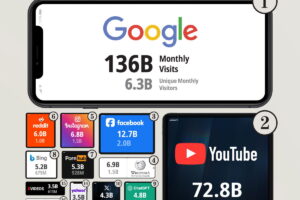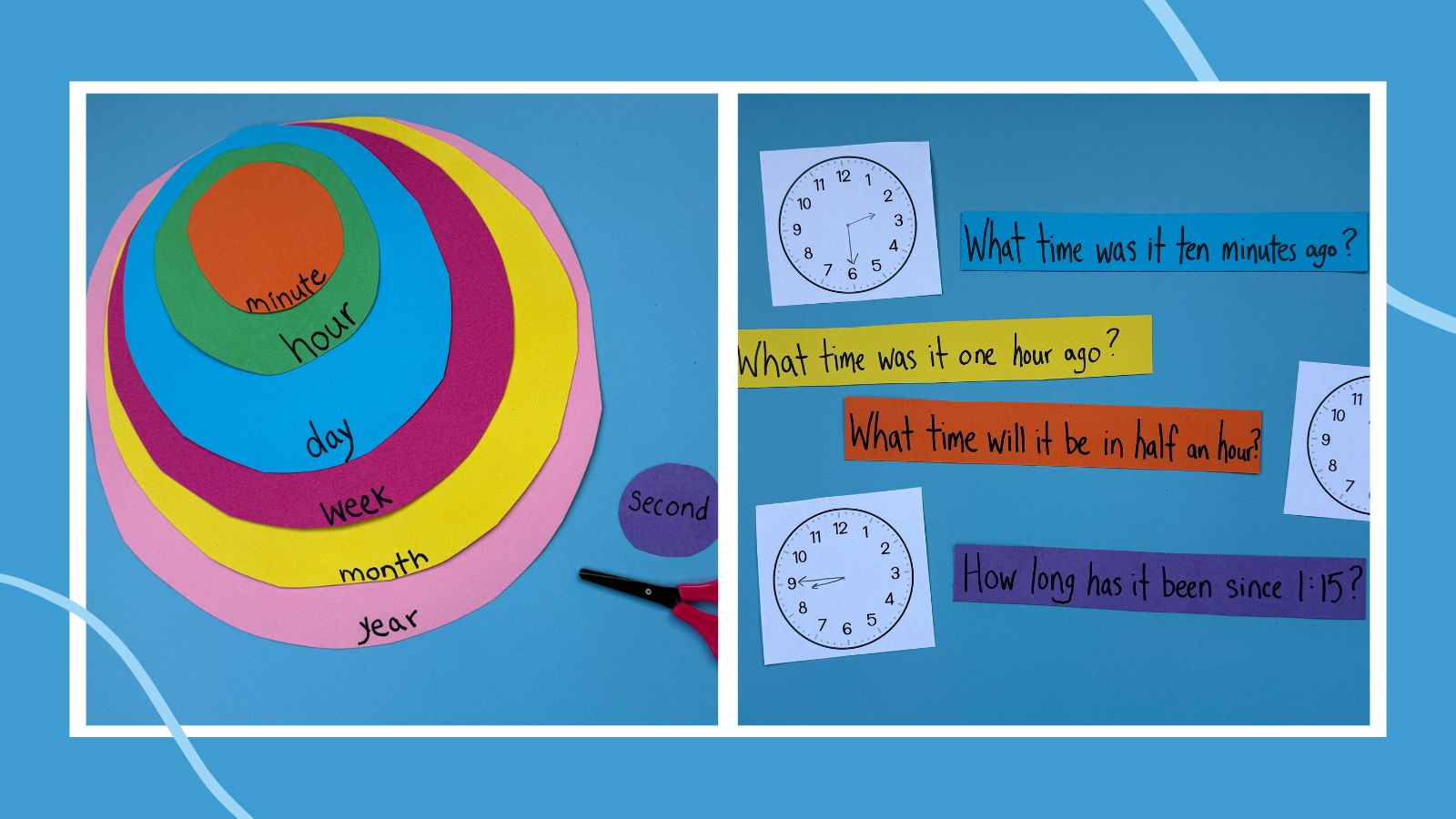
31 Fun Telling-Time Games and Activities
Learning to tell time is an important early math lesson since it’s a real-world skill that’s used every day by everyone. Learning about minutes and hours can become tedious fast, so you’ll want to have a lot of creative and hands-on ways to bring it to life for kids. Whether you get crafty with a paper watch or active with musical clocks, your students will have a good time learning all things time. There are, of course, old standbys on our list, too, like books and worksheets. Kids can even get in some extra practice with a free online game or two. Check out our personal favorite telling-time games to try with the kiddos in your life.
Jump to:
Hands-On Activities for Telling Time
1. Make a paper clock
Kids sometimes get confused about the meanings of the numbers on the clock. For instance, a 3 means 3 o’clock but also 15 minutes. This clever paper clock, with lift-up flaps, will help learners grasp the concept. To begin, cut two 8-inch circles from pieces of colored card stock. On the top circle, write the numbers 1 through 12, making sure they are equally spaced. Between each number, cut a 2-inch slit from the edge toward the center.
Cut a slim 4-inch arrow from the leftover card stock and label it “minute.” Cut a 3-inch arrow and label it “hour.” Stack the top circle (the one labeled 1–12) on top of the blank bottom circle. Attach the hour and minute hands through the center of both circles. Make sure the arrows are loose enough to rotate.
Finally, lift each flap of the top circle and write the corresponding time on the bottom plate. For instance, lift the 2 and write :10, lift the 6 and write :30, etc. Students can practice telling time by setting the hands of the clock, guessing the time, and lifting the flaps to check their answers. To make this activity even easier, use paper plates instead of card stock.
2. Color the spaces to learn the hours

Many children get confused about reading the time on an analog clock, especially when the hour hand falls between two numbers. For instance, at 4:00, it’s clear that it is 4 o’clock on the nose. However, when the clock ticks on to 4:55, it’s a little trickier to read.
Try this easy activity to help your students understand the concept. Print out a worksheet with multiple clockfaces and give one to each student. On a large clockface, demonstrate to your students how to read the time between 12:00 and 12:59. Color in the triangle between the center point, the 12, and the 1. Explain: If the hour hand is anywhere in this color zone, the time is read as 12-something. Move the hands on your clock and demonstrate: 12:05, 12:20, 12:45, and finally 12:59. Once the hour hand is directly over the 1, the time is read as 1-something. Color in the triangle between the 1 and 2 a different color and proceed as above. Have students follow along on their worksheets as you work together, then fill in the rest of the triangles on their own.
3. Put a puzzle together

There are three common ways to represent time: with a drawing of a clock, with numbers, and with words. Help your students make the connection with these easy three-piece time puzzles. Using colored index cards, draw a set of matching time cards. For example, a clock set to 5:15, the numerical representation 5:15, and the words “five fifteen.” Use different-colored sets of three to create more puzzles, or better yet, have your students create their own.
4. Drive home the concept with linking math cubes
This hands-on demonstration will help reinforce your students’ understanding of time. Gather students in a circle on the rug. In the center, place a large piece of chart paper. Have a bucket of linking cubes nearby. Draw a large clockface on the paper, labeled appropriately from 12 o’clock to 11 o’clock. Ask a student volunteer to link five cubes together. Place the link between the 12 and 1. On the outside of the circle, write the number 5 adjacent to the 1. Explain that the link represents the five minutes between the 12 and the 1.
Next, ask another student volunteer to link five cubes together. Lay this between the 1 and the 2. On the outside of the circle, write the number 10 adjacent to the 2. Continue around the circle, inviting different students to participate. When the circle/clock is complete, go around the circle and count by fives, driving home the concept.
5. Make a rock clock
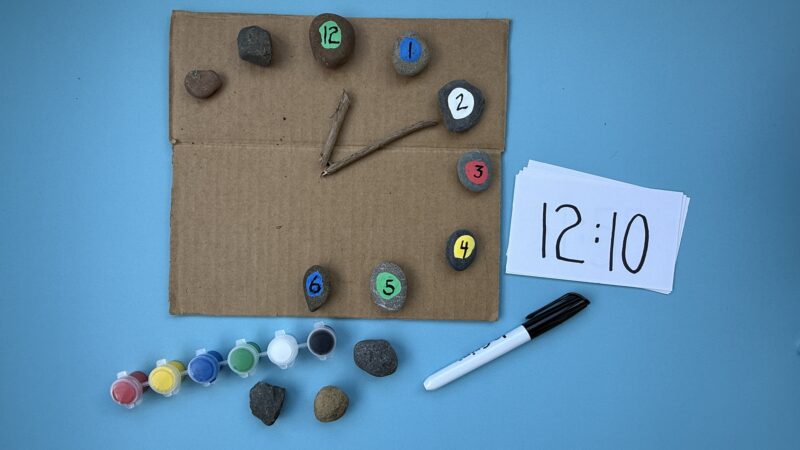
This activity is a fun way to blend art and math. First, take your class outside to gather rocks and sticks. Each student should have 12 similar-size rocks and two sticks (or one that can be broken up). Have students paint their rocks a bright color, and when they are dry, label each with the numbers 1 through 12. Arrange the numbers of the clock (the rocks) in a circle on a sturdy paper plate. Break the sticks into the appropriate length to represent the hour and minute hands. Finally, call out different times and have students practice representing that time on their beautiful clocks. Give each student a large ziplock bag to store their clocks for future use.
6. Take it outside with a Hula-Hoop clock
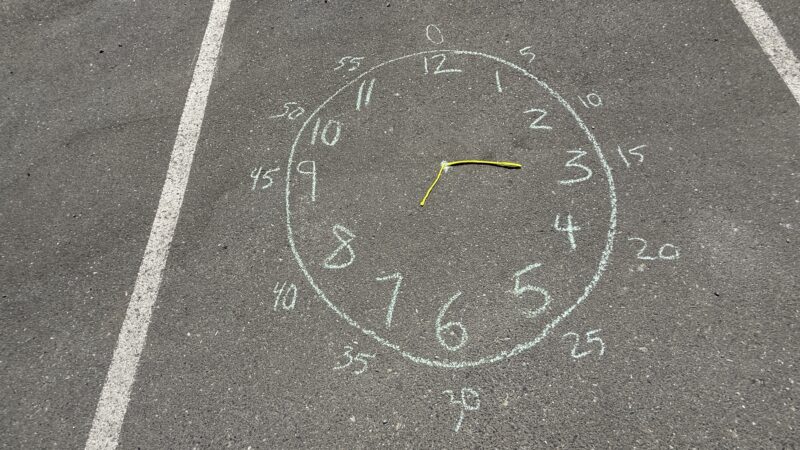
Pull out the sidewalk chalk and head outside for some practice telling time. Hula-Hoops make perfect analog clocks, but if you don’t have any, kids can simply draw large circles instead. Pair students up and give each pair a Hula-Hoop, two pieces of chalk, and two pipe cleaners (one longer than the other). Have them work together to write the numbers on the inner circle. On the outer circle, have them write the corresponding units of 5. For instance, at 1:00 write 5, at 2:00 write 10, etc.
To play, students will take turns practicing setting the time. One student will call out a time and the other student will use the pipe cleaners to set that time. The caller will check for correctness, and then they will change places.
7. Set the time with play dough
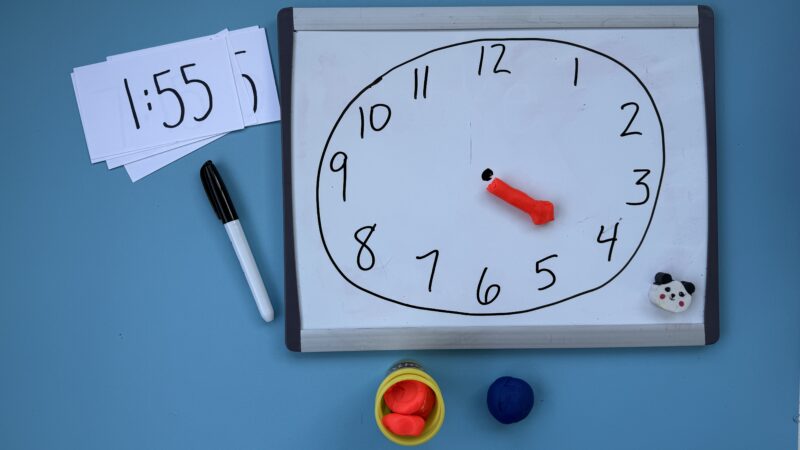
This is a playful, hands-on way to practice telling time. Simply provide students with a dry-erase board, a marker, and two blobs of play dough in different colors. First, students will draw a circle and label it as a clock. Then, they will roll out the play dough to create the minute and hour hands. Make sure they make the hour hand shorter than the minute hand. Have students practice telling time by setting the hands on their clock, reading the time aloud, then writing the time out in the proper form (with numbers and a colon) on a recording sheet.
8. Distinguish between a.m. and p.m.
Remembering the difference between a.m. and p.m. can be a bit confusing at first. To practice with your class, play this fun hands-on game. To begin, choose a student to call out an activity—for instance, eating dinner. Then, have the other students put their hands on their head if they think that happens in the a.m. If they think it happens in the p.m., have them cross their arms across their chest. Reveal the correct answer, then choose another student to call out an activity. Continue until everyone who wants to call out an activity has been chosen.
9. Play a round of headbands
Create fun clock headbands with moveable arms for this game. First, have students cut out a blank clock template and attach colored-paper arms with a brad in the center. Next, glue the clock to a larger circle cut from construction paper. Finally, attach the large circle to a thick strip of construction paper and form the strip into a headband. These clock headbands are not only fun and silly to wear, they’re perfect for a game of What Time Am I? Kids set a time on their clock, then circulate and ask other kids to tell them what time it is.
10. Dance around with a quick round of musical clocks
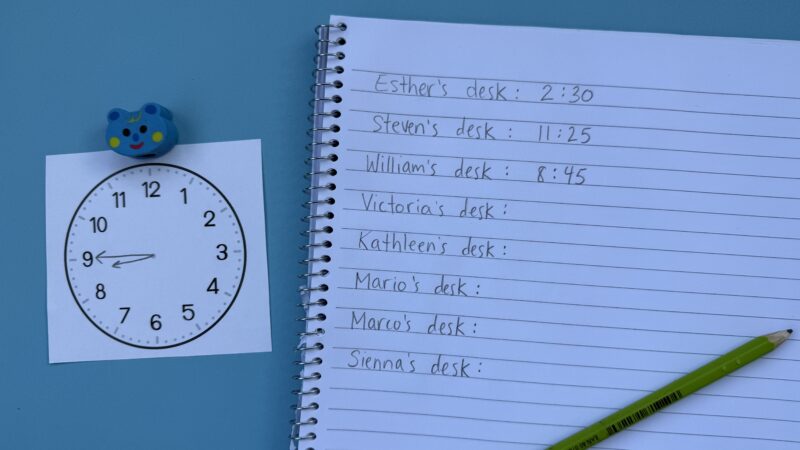
If your students love to play musical chairs, they will love this telling-time version of the game. Pass out a clockface worksheet to each student and have them draw a time on their clock. Then, have them leave it on their desk. Give each student a recording sheet, then have them grab a pencil and get ready to move!
Start the music and let kids dance around from desk to desk. When the music stops, students will record the time on the clock of the desk in front of them. (Have them also write the name of the student who wrote that time to check for accuracy.) Start the music again and keep on going!
11. Shake up the time of day
This awesome time-telling game also gives kids practice with bar graphs. To prepare the shaker, simply paste small analog clockfaces showing various times into the bottoms of an empty cardboard egg carton and add a marble. For the recording sheet, give each student a blank bar graph template. Guide your students to label the x-axis with the hours on a clock (1–12) and the y-axis with the minutes (5–55).
To play, divide students into groups of three or four. The first student will shake the carton, then open the top to see what time the marble landed on. Then all of the students will color in the block of the first roll on their bar graph. Continue play until time is up. Make sure students are working together and checking one another’s answers.
12. Add a hook to the hour hand
This clever time-telling trick will help your students master reading the minute hand as the hour hand shifts. To demonstrate, use a large clock without the plastic cover over the face. Attach a piece of pipe cleaner in the shape of a backward J to the hour hand. Set the clock to the top of an hour—for example, 3:00. Now slowly rotate the minute hand and watch the hour hand as it moves to the right. Explain to students that until the pipe cleaner is cleanly aligned with the 4, all the times will be written as 3:something. The hook of the J will remind them to look back, not forward. If possible, have students practice on mini clocks of their own.
13. Write the room with I Spy time
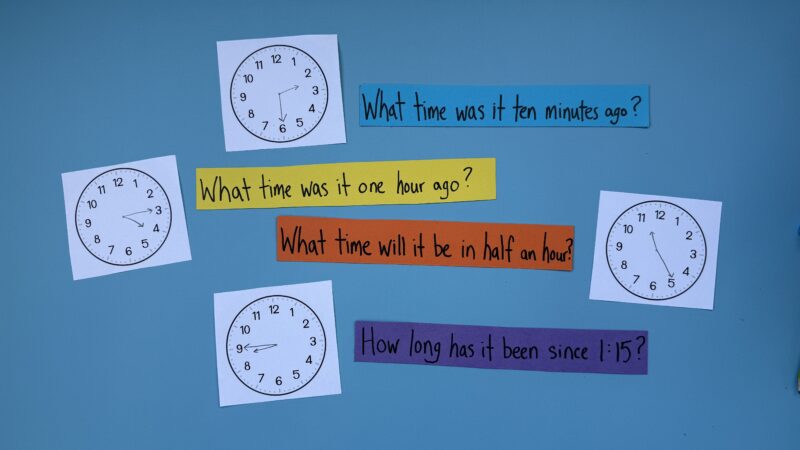
Write the Room activities are a fun way to get your students up and moving. For this fun time-telling activity, post paper analog clocks with times filled in around the room. On each clock sheet, also write a challenge question such as “What time was it 10 minutes ago?” or “What time will it be in half an hour?” etc. Have students travel with a record sheet, pencil, and clipboard. When they find a clock, they record the time on their record sheet. They get a point for each correct answer. For each challenge question they get right, they get two points. When you check your students’ work, you will be able to tell who needs more work and who needs more instruction.
14. Match up plastic eggs
There are so many fun ways to use plastic eggs in the classroom. Try this fun activity to help your students practice telling time. Prepare ahead of time by writing times (in words or digital time) on half of the eggs and analog clocks with the same times on the other halves. Mix up the colors so students have to really look closely to make a match. This is a great activity for station work or early finishers.
15. Make your classroom clock bloom
Turn a classroom wall clock into a pretty flower to reinforce what your students have learned about telling time. Attach flower petals cut from bright-colored construction paper around the perimeter of the clock. Be sure to label each petal with the corresponding minutes for each number on the clock. Add a colorful stem at the bottom with a short leaf labeled “hour” and a long leaf labeled “minute” to remind students which hand on the clock is which.
16. Teach units of time with concentric circles

We love this activity that helps students put different units of time in perspective. To create this time wheel, students will need to cut seven concentric circles out of colored construction paper. Start with the smallest circle, then cut each of the following circles a bit larger. Each circle should be a different color. Connect the circles together with a brad. Then, starting with smallest circle and working their way out, have students label the circles in this sequence:
- Second
- Minute
- Hour
- Day
- Week
- Month
- Year
The visual representation of colored circles will help students absorb and retain the concept. Have them keep their time wheels in their desk for future reference.
17. Calculate the duration of your favorite activities

Are your students ready to tackle elapsed time? This visual activity will help them apply telling time to their everyday lives. Create a worksheet with three columns and three rows. In the first two columns, insert an analog clock without arms. Leave the third column blank. Label the three rows Activity #1, Activity #2, Activity #3.
To begin, ask students to choose three activities they do. For instance: soccer practice, art class, eating breakfast, doing homework, etc. To fill in their chart, have students label each row with the name of the activity. Then, on the first clock, they will draw in the time the activity started. On the second clock, they will draw in the time the activity ended. In the third column, they will write the total time the activity took. Repeat for each activity.
18. Play Rush Hour
This is a fun game to play with partners or small groups. Each student will need their own mini teaching clock (like a Judy clock) and each pair or group will need a die. To begin, have each student set their clock to 12:00. To play, students will take turns rolling the die, reading the direction card, and moving their clock the correct amount of time. The direction cards should read as follows:
- Move ahead 5 minutes.
- Move ahead 10 minutes.
- Move back 5 minutes.
- Move ahead 15 minutes.
- Move ahead 20 minutes.
- Move back 10 minutes.
The round ends when the first player makes it all the way around the clock to 1:00.
19. Read books about telling time
What better way to teach just about anything than with books? Search your school library, your classroom library, and online and brick-and-mortar sources for books about telling time. Then, pick a few of your favorites and read them aloud during math time.
20. Play Telling-Time Bingo

Kids love to play bingo so why not use it for time-telling practice? Search the internet for a customizable analog clock bingo card template or create your own. Label the clocks on the card with whatever time skills your students are working on, whether it’s hours, half hours, quarter hours, or to the minute. Copy the card and pass one out to each student. Then, play a few rounds of bingo using the usual rules.
21. Beanbag time
Linking concepts to physical movements helps students integrate learning. For this active game, line students up in the middle of the classroom, or better yet, play this game outdoors. Give each student a beanbag. Place papers with different times, written in analog, digital, and word forms, on the floor around the room. Then call out a time. Students will need to find the time and accurately toss their beanbag onto the paper. Give students a minute to retrieve their bags, and call out the next time. If students wish to change places in line during the game, that is allowed.
Online Telling-Time Games
22. Travel through time
ABCya has a lot of free online games for young kids that you can play even without a subscription. This fun time-travel game allows kids to choose whether they want to practice setting a digital or an analog clock. We especially love the time-traveling theme and the cute cartoon graphics that make this activity extra kid-friendly.
Learn more: Time-Travel Game at ABCya
23. Pick the right answer
This simple and free game doesn’t even require a sign-up to begin playing. Kids are given multiple-choice options to select from when guessing the time displayed on the analog clock. Kids receive 10 points for every correct answer given and lose 10 points for every incorrect one. We think kids will have fun trying to beat their high scores!
Learn more: Telling Time at Toy Theater
24. Tell time to the quarter hour
This site has a lot of different online telling-time activities across different difficulty levels. We are especially fond of the one that requires students to tell time to the quarter of an hour. Kids are presented with four different analog clockfaces and asked to select which one displays the time at the bottom.
Learn more: Clockworks Practice at Mr. Nussbaum
25. Recognize patterns
We love that this game combines learning time with pattern recognition. This website has additional time-telling games should the kids in your life master this one!
Learn more: Time Patterns at Math Games
26. Personalize the learning experience
This free online game offers up a lot of room for personalization. You can select whether to identify time to the nearest hour, half hour, quarter of an hour, or even minute. You can also select a 12-hour or 24-hour clock. Depending on your child’s skill level, you can also select to play in timed or untimed modes. The adorable circus theme and bear ringmaster will keep any kid entertained!
Learn more: Telling the Time at Mathsframe.co.uk
27. Practice with elapsed time
Telling-time games that go beyond just identifying a time on a clock are some of our favorites for older kids. This one requires kids to identify the time on an analog clock and then decipher what time it will be in a certain number of hours.
Learn more: Time Teller at RoomRecess.com
28. Compare digital and analog
This site begins by explaining the differences between digital and analog clocks as well as how to read each one. It then takes you through various exercises to test your understanding.
Learn more: Telling the Time: Digital and Analog at Tiny Tap
29. Make the mouse run up the clock
This is such a fun spin on identifying the time on a clock. We love the play on a classic nursery rhyme and the oh-so adorable mouse and cat graphics. Guess the right time on the cartoon grandfather clock and a cute mouse will run up it. But get it wrong and an angry cat will make itself known!
Learn more: Hickory, Dickory, Clock at ICT Games
30. Take a quiz
This video is advertised as being for English language learners, but it would work equally well for kids just learning to read clocks. Kids can just watch it or they can keep some scrap paper handy to record their answers.
Learn more: Telling the Time Quiz on YouTube
31. Race to the correct time
What’s more fun than playing a game with friends? Multiple players can play against one another as their adorable giraffe avatars race to be the first one across the finish line.
Learn more: Giraffe Dash at Arcademics
Get Math Vocabulary Words Printables

We have two lists: one for grades K-3 and one for grades 4-6. Each set of words is organized by concept strand and then alphabetized for easy use. Fill out the form on this page to receive your copy!
How do you teach telling time? Come exchange ideas in the We Are Teachers HELPLINE group on Facebook.
Plus, check out Creative Ways To Dress Up Your Classroom Clock!
Source link



